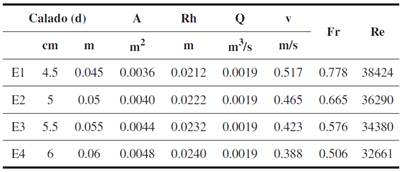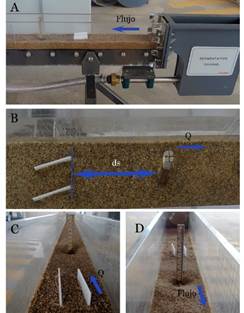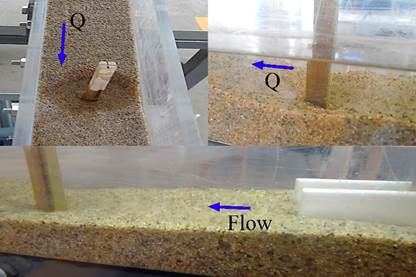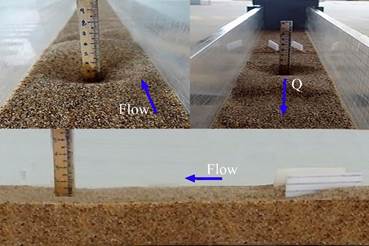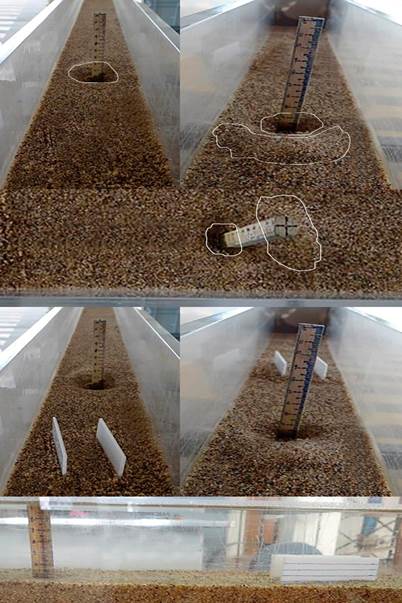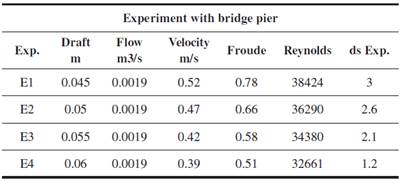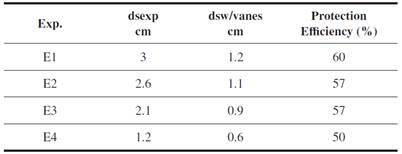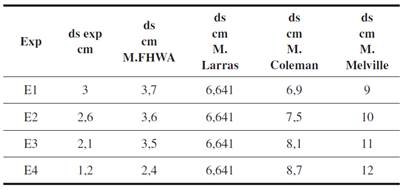I. INTRODUCTION
Scour remains one of the most critical challenges in civil engineering, being the leading cause of structural settlement in the vicinity of bridge piers. Predicting scour depth, understanding its mechanisms, and defining the equilibrium dimensions of scour holes are fundamental for the hydraulic design of bridges, ensuring their stability under varying channel and flow conditions [1]. These considerations require a comprehensive understanding of key parameters such as sediment size, flow velocity, and the geometric characteristics of bridge piers, as they directly influence the structural safety of hydraulic infrastructure [2].
Local erosion around bridge piers occurs due to the removal of bed material, creating a localized flow action that significantly lowers the riverbed around the pier. This process involves two subprocesses: active and passive erosion. The active phase originates at the bottom of the scour hole upstream of the pier, driven by the horseshoe vortex—a flow structure with a horizontal axis whose size depends on the water level [3]. The passive phase, characterized by the intermittent collapse of scour hole walls, is entirely dictated by the dynamics of the active phase. These flow structures amplify bed material displacement and exacerbate scour depth, particularly under clear-water conditions [4]; [5]. The complexity of these subprocesses underscores the need for targeted mitigation strategies to reduce local shear stress and stabilize sediment dynamics.
Traditional methods for mitigating scour, such as riprap, concrete aprons, groins, and spurs, have been widely used in hydraulic engineering. While effective, these methods often come with limitations such as high construction costs, reduced adaptability to dynamic flow conditions, and potential ecological disruption [2]. Comparative analyses reveal that submerged vanes offer a more economical and adaptable alternative, particularly in environments with complex sediment transport dynamics [6]. Unlike riprap, which can be dislodged during high-flow events, submerged vanes actively modify flow patterns to reduce bed shear stresses, making them less prone to failure [7].
Submerged vanes have emerged as a viable and cost-effective solution for controlling sediment transport and mitigating local scour [7]. These structures generate secondary circulation, altering velocity distributions and reducing bed stresses (Hamidi et al., 2024).
Experimental studies and numerical simulations have highlighted the importance of optimized design parameters, such as angles of attack and vane placement, in minimizing scour depth. For instance, dual submerged vanes have been shown to reduce scour depth by up to 33 % when positioned at specific angles and distances relative to the pier diameter [8]; [9]. Similarly, [5] demonstrated that incorporating collars at the leading edges of submerged vanes effectively prevents local scour, further enhancing their stability and efficiency.
While submerged vanes present clear advantages, challenges remain, particularly in highly turbulent flows or sediment transport systems dominated by coarse materials [5]; [10]. Studies have shown that rectangular vanes often underperform under these conditions, necessitating alternative designs to enhance their stability and effectiveness. For instance, modifications such as tapered or angled vane configurations have demonstrated improved flow redirection and sediment redistribution capabilities, particularly in reducing shear stresses near bridge piers [11] [12] further highlighted that the application of curved vanes significantly enhances scour mitigation in systems dominated by coarse sediments.
Furthermore, most existing studies focus on circular bridge piers, leaving a significant gap in understanding scour mitigation around square piers. Square piers, with their sharp edges, exacerbate turbulence and increase vortex strength, making them particularly vulnerable to scour [13]; [14]. The three-dimensional nature of the flow around square piers further complicates the problem, as increased velocity gradients form horseshoe and wake vortices that intensify bed material displacement [3].
This study addresses these gaps by exploring the use of submerged vanes specifically designed for square bridge piers. Experimental findings highlight that the strategic placement of vanes upstream of the pier can reduce scour depth by up to 30%, particularly in sharp bend configurations [15]. Additionally, recent reviews emphasize the importance of optimizing vane dimensions and configurations, such as aspect ratios and angles of attack, to maximize sediment control and hydraulic stability [16]. By tailoring vane design and positioning to clear-water conditions, this research aims to achieve equilibrium states that balance erosion control and sediment deposition, offering a practical and sustainable methodology for improving hydraulic stability.
II. MATERIALS AND METHODS
The experimentation was conducted in the channel of the Hydraulic Teaching Laboratory of the Faculty of Civil and Environmental Engineering at the National Polytechnic School (EPN), Quito, Ecuador. The channel features a closed water circuit driven by a pump, capable of reproducing conditions from the incipient movement of particles to bed washout. Discharge flow rates were measured using weirs, and the channel's inclination can vary from 0 to 10 %. Figure 1 shows the channel, which is 1.55 m long, 78 mm wide, and 110 mm deep.
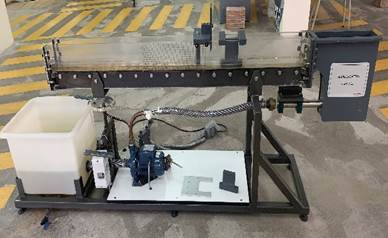
Fig. 1 Sediment Transport Demonstration Channel (Sedimentation Channel Operation Instructions, 2004, Cussons brand).
The design conditions of the submerged vanes experimented with in this research depended on the scenario in which the process was conducted. The primary objective was to mitigate the local scour hole that forms at the bridge pier, generating vortices that affect downstream flow. The height of the vane depended on the draft, as well as the spacing between vanes and the walls of the sedimentation channel, ensuring sufficient sediment redistribution to stabilize the scour hole.
Four systematically designed tests were conducted to evaluate the influence of submerged vanes on local scour around a square bridge pier. Each test was performed under controlled laboratory conditions to ensure reproducibility and accuracy. The submerged vanes were installed upstream of the pier at a 15° attack angle relative to the flow direction. [7] established that this angle optimizes secondary circulation, reducing bed shear stress and enhancing sediment redistribution. Subsequent studies, including [5], [11], and [4], validated that angles below 20° effectively promote horizontal vortices while maintaining manageable hydraulic resistance. Additionally, [8] demonstrated that dual submerged vanes positioned at optimal angles can reduce scour depth by up to 33 %, making them a viable solution for real-world applications.
During the experiments, the water draft was systematically varied while maintaining a constant flow rate, ensuring that clear-water conditions prevailed. This approach allowed for consistent development of the scour hole until equilibrium was achieved. Discharge flow rates were measured using a rectangular weir at the channel's outlet, and the Hegly equation (1921) was applied to ensure accuracy. Calibration of the weir was verified before each test to minimize measurement errors.
Boundary conditions were carefully controlled to prevent external influences on erosion evolution. Following [17], the pier's dimensions were set at least 10 % of the channel width, using a 10 mm square wooden pier. Quartz sand with a characteristic diameter of 0.74 mm and σg < 3 was selected, as its uniformity facilitates reproducibility and aligns with sediment properties commonly used in hydraulic studies. The sand was distributed uniformly along the channel, with the bridge pier placed at its center, 50 cm from the starting point.
The channel allowed for control of critical variables, such as flow rate and inclination, essential for simulating real-world conditions. Using square piers ensured that the study addressed challenges unique to their geometry, as sharp edges exacerbate turbulence and increase vortex strength [13]; [14].
The submerged vanes were designed using the equations proposed by [7] to modify flow dynamics effectively and reduce local scour depth. The attack angle of 15° was selected based on its hydraulic efficiency demonstrated in prior studies. This choice balances efficiency with practical implementation, avoiding the excessive flow resistance associated with larger angles [11]; [12]. Additionally, [9] highlighted the importance of proper vane spacing and alignment for maximizing sediment redistribution in controlled conditions.
The variation of the water draft in the tests allows observing the effect of different flow levels on local erosion. Maintaining a constant flow rate ensures that observed differences are due to the influence of the submerged vanes and not changes in flow. This approach strengthens the reliability of the results, isolating the impact of the submerged vanes from other potential variables.
Table 1 presents the boundary conditions with the different drafts and scenarios conducted in each test.
The submerged panels were dimensioned according to the equilibrium scour hole characteristics observed in each test, following the equations proposed by [7]. These equations ensure that the panels are optimally sized to modify flow dynamics effectively, promoting sediment redistribution while minimizing local scour depth. These equations were used to determine the optimal dimensions of the submerged vanes, considering the draft of each test, the spacing between vanes and the channel walls, and the distance from the edge of the pier to the edge of the submerged vanes.
The equations used are as follows (Eq. 1-2-3-4):
Where:
H: Height of the submerged panel.
L: Length of the submerged panel.
ds: Distance from the edge of the pier to the start of the panel.
dn: Distance between vanes.
db: Distance from the channel wall to the submerged panel.
Table 2 establishes the dimensions of the submerged vanes tested for each trial.
The implementation of the submerged vanes in each of the tests is shown in Figure 2.
III. Results and Discussion
Test E1
In test E1, the evolution of the erosive phenomenon was observed during the first hours of the test. The development of the horseshoe vortex initiated the active subprocess, followed by the collapse of the scour hole walls in the form of intermittent collapses, as shown in Figure 3. The scour hole reached its equilibrium state at 10 hours into the test. The early-stage aggressiveness of the erosion process highlights the dominance of vortices under lower drafts, which amplify bed shear stress and sediment mobilization. These findings align with the work of [2], emphasizing the critical role of draft height in influencing local scour dynamics. Additionally, the observed trends are consistent with the studies of [10], which demonstrate the importance of hydrodynamic parameters in shaping scour morphology.
Test E2
In test E2, the onset of movement was ensured to maintain clear-water conditions throughout the process of local erosion evolution. The erosive phenomenon reached its equilibrium state at 13 hours into the test. It was observed that the erosion process occurred more rapidly during the initial hours, both in the formation of the scour hole and in sediment transport downstream of the pier, as shown in Figure 4. Compared to test E1, the erosion rate deceleration observed in the latter stages indicates a stabilization process driven by increasing draft height, which reduces flow turbulence near the bed. These results support the hypothesis of [5], which states that drafts exceeding the critical depth minimize sediment disturbance and enhance sediment stability.
Test E3
In test E3, clear-water conditions were maintained to ensure comparability with the previous tests. In this case, the erosive phenomenon was less aggressive due to a greater draft, resulting in lower bed stress and smaller characteristic vortices. The erosive phenomenon reached its equilibrium state at 14 hours into the test, as shown in Figure 5. The reduced erosion rates confirm the theoretical relationship between draft height and vortex intensity, as described by [7]. These findings are further corroborated by the results of [8], who demonstrated a significant reduction in scour depth under controlled hydrodynamic parameters.
Test E4
In the final test, the pier was positioned at the point of incipient motion, as in the previous experiments. With a greater draft, the flow velocity and bed stress were lower, resulting in a slower and less aggressive development of the erosive phenomenon. Despite this, the formation of the horseshoe vortex in front of the pier and the wake vortex downstream was observed, causing sediment transport. Figure 6 shows the development of the erosive phenomenon at 16 hours into the test when it reached its equilibrium state. The slower progression of scour and reduced depth highlight the stabilizing effects of higher drafts. This behavior aligns with the studies of [18] and [12], confirming the critical role of draft height in controlling scour dynamics.
Table 3 presents the conditions for each experiment once the erosive phenomenon had developed, as well as the maximum experimental scour depth (ds). The results reveal a direct correlation between draft height and scour depth, with lower drafts generating deeper scour holes. This behavior agrees with established theories [2] and demonstrates the critical role of flow velocity and turbulence intensity in shaping scour morphology.
Error margins were calculated by repeating each experiment three times under identical conditions. The standard deviation of ds across trials ranged between ±0.1 cm and ±0.2 cm, indicating high repeatability and reliability of the experimental methodology.
The implementation of submerged vanes significantly reduced scour depth, achieving an average protection efficiency of 58 % across all tests. These findings confirm their ability to alter flow patterns and mitigate bed shear stress effectively, as summarized in Table 4.
Table 5 compares experimental results with theoretical methods, showing that the FHWA (HEC-18) method [19] produced results closest to the experimental data, with deviations within ±10%. Other methods, such as [2], tended to overestimate scour depth due to assumptions of higher turbulence intensity.
The results confirm the high effectiveness of submerged vanes in reducing the depth of the scour hole around bridge piers. This effectiveness stems from their ability to modify flow patterns, redistribute velocities, and reduce the erosive capacity of the flow. These findings are consistent with prior studies that demonstrate the efficacy of submerged vanes in mitigating local erosion [7]; [20]. Furthermore, the comparative analysis using various methods for calculating maximum erosion revealed that the FHWA (HEC-18) method provides predictions closest to the experimental results, with deviations within ±10%, validating its application under clear-water conditions [19]. These results reinforce the potential of submerged vanes as a scalable and practical solution for mitigating local scour.
However, practical implementation, especially in large-scale applications, poses certain challenges. A significant limitation is the cost associated with the fabrication and installation of vanes, particularly when durable materials are required to withstand harsh environmental conditions and prolonged submersion. Durability under highly turbulent flows or in environments dominated by coarse sediment transport is another critical concern, as these factors can lead to increased wear and reduced efficiency over time [12].
Scaling up submerged vane deployment also introduces logistical complexities, such as precise alignment during installation and maintaining optimal spacing to ensure effective sediment redistribution. Innovative approaches, such as modular vane designs or materials with enhanced erosion resistance, could help address these challenges. Additionally, field studies in diverse hydraulic environments would provide valuable insights into their real-world performance, offering a clearer picture of their adaptability and long-term effectiveness.
Despite these challenges, the adaptability, proven performance, and cost-effectiveness of submerged vanes underscore their potential as a practical solution for mitigating local scour. Future research should focus on cost-benefit analyses, exploring ways to reduce manufacturing costs, optimize vane configurations for various hydraulic conditions, and test their performance in field-scale implementations. Addressing these aspects will enhance their applicability and ensure their scalability as a robust solution for protecting hydraulic structures against local scour.
IV. Conclusions
The study determined that the erosive phenomenon develops continuously over a period known as the equilibrium state. During this phase, the vortices gradually diminish, leading to a cessation of interactions between the active and passive subprocesses of scour. This stabilization ultimately results in equilibrium in downstream sediment transport.
The results obtained for maximum erosion, calculated using the different methods presented in Table 5, revealed discrepancies when compared to the experimental results. These differences arise from limitations in accurately determining velocities near the onset of local erosion and the specific conditions under which the calculation methods were developed. Despite these discrepancies, the FHWA (HEC-18) method provided predictions closest to the experimental results, validating its application under clear-water conditions. This reinforces its practicality as a reliable tool for preliminary design in scenarios where site-specific hydraulic conditions resemble those of the controlled experiments.
Laboratory tests clearly demonstrated that submerged vanes can induce significant changes in flow velocity distribution, effectively modifying the depth and shape of the local scour hole around square bridge piers. This behavior is attributed to the reduction in bed shear stresses caused by the vanes. Specifically, the implementation of two submerged vanes upstream of the bridge pier generated vortices that influenced a broader area of the channel cross-section, ensuring complete coverage of the scour hole in all experiments. The evolution of the active and passive subprocesses varied across tests, influenced by the water draft, which controlled the vortex intensity. Consequently, the formation and equilibrium time of the scour hole differed, with a corresponding reduction in shear stress observed in each case. This systematic variation highlights the adaptability of submerged vanes to varying hydraulic conditions, providing a flexible tool for site-specific sediment management strategies.
From a practical perspective, the use of submerged vanes presents a promising solution for mitigating local scour in real-world applications. These vanes could be strategically implemented in river systems with high sediment transport activity, especially in areas with sharp bends or regions experiencing significant turbulence where traditional methods, such as riprap or aprons, are less effective. Furthermore, their adaptability makes them suitable for retrofitting existing bridge infrastructure in locations where erosion poses an ongoing threat. However, practical challenges such as precise alignment during installation and ensuring structural integrity under fluctuating hydraulic loads remain areas that require further exploration. However, practical challenges such as precise alignment during installation and ensuring structural integrity under fluctuating hydraulic loads remain areas that require further exploration. Addressing these factors will be essential for maximizing the vanes' effectiveness in field applications.
Future research should focus on addressing the economic and material challenges associated with large-scale implementation. Optimizing the panel design for durability in highly turbulent flows and coarse sediment transport conditions is crucial. Cost-benefit analyses and long-term performance evaluations will also be essential to promote their widespread adoption. Moreover, developing guidelines for scaling laboratory results to real-world scenarios will help standardize the use of submerged vanes in hydraulic engineering projects. Additionally, field studies in diverse hydraulic settings will help validate laboratory findings and provide critical insights into real-world performance, especially under variable sediment and flow conditions.
In summary, submerged vanes have proven to be an effective, economical, and practical technique for controlling local erosion around square bridge piers. Their ability to modify flow patterns, reduce shear stress, and enhance structural stability under varied flow conditions highlights their potential as a sustainable and innovative solution in hydraulic engineering. Their demonstrated scalability and efficiency position them as a viable alternative to traditional erosion control measures, capable of addressing the limitations of existing approaches. This positions submerged vanes as a transformative tool for future scour mitigation practices.














